
Overview Development and origin of patent applications
Although the number of patent applications and requests for examination received was still high in 2020, we recorded a decline compared to the previous year. The number of registered patent applications fell by 7.9% compared to the updated figure for the previous year to amount to 62,105.
This decline in applications is probably mainly due to the coronavirus pandemic. Short-time work or difficulties with the necessary switch to new forms of cooperation have left their mark on research and development departments of enterprises and institutions, so it was not possible to push the technical development and the preparation of patent applications as before. Furthermore, we assume that, because of the hardly predictable financial effects of the pandemic, the enterprises also waived applications with less good prospects in order to save costs.
Of the 62,105 patent applications registered last year, 54,580 were filed directly with our office. 7,525 applications entered the national phase as PCT applications in accordance with the Patent Cooperation Treaty (PCT) through the World Intellectual Property Organization (WIPO) in Geneva.
The option of electronic filing is still very popular with our customers, as can be seen from a slight increase by 0.5 percentage points to a proportion of 86.9% of all filed patent applications.
At the end of 2020, 132,336 national patents were in force, i.e. 0.3% more than in the previous year.
In 2020, 42,249 applications were filed by applicants having their domicile or principal place of business in Germany (-9.4%). This means that the percentage of applications from Germany fell slightly to 68% (2019: 69.2%). Likewise, the number of patent applications from abroad dropped to 19,856 (2019: 20,798).
Last year, 3,222 applications came from European countries (2019: 3,635) and 16,634 from non-European countries (2019: 17,163).
Applications from the Republic of Korea increased by 28.1%. The number of applications from Taiwan (26.6%) and from China (11.4%) also increased. By contrast, applications from the United States (-5.2%) and Japan (-8.9%) continued to decrease.
| Countries of origin | Applications | Percentage |
|---|---|---|
| Germany | 42,249 | 68.0 |
| Japan | 7,247 | 11.7 |
| USA | 5,882 | 9.5 |
| Republic of Korea | 1,617 | 2.6 |
| Taiwan | 933 | 1.5 |
| Switzerland | 777 | 1.3 |
| Austria | 765 | 1.2 |
| China | 499 | 0.8 |
| Sweden | 321 | 0.5 |
| France | 301 | 0.5 |
| Others | 1,514 | 2.4 |
| Total | 62,105 | 100 |
The patent applications from Germany can be allocated to individual German Länder according to the residence or the principal place of business of the applicant. The German Länder ranking is again led by Baden-Württemberg with 13,687 applications (-10.2%). 12,700 applications were received from Bavaria (-9.5%), which comes second in the ranking. North Rhine-Westphalia followed far behind with 6,388 applications (-9.0%) and again came in third just as in the previous year. Schleswig-Holstein recorded a slight increase by 2.3% to 480 applications in 2020. Hesse also saw an increase by 1.9% to 1,571 applications. Thuringia and Mecklenburg-West Pomerania increased the numbers of applications by 1.3% and 20.2%, respectively.
If we compare the filing figures to the respective numbers of inhabitants, Baden-Württemberg and Bavaria were again in the lead with 123 applications and 97 applications respectively per 100,000 population. As in the previous year, Lower Saxony came in third (40).
If the cursor is moved over the chart, it shows the patent applications in 2020 per German Länder (residence or principal place of business of the applicant).
With 4,033 applications, Robert Bosch GmbH again led the ranking of the most active patent applicants in 2020. It was again followed by Schaeffler Technologies AG & Co. KG with 1,907 applications. Bayerische Motoren Werke AG again came in third with 1,874 applications. Daimler AG followed in the fourth place with 1,638 applications, relegating Ford Global Technologies, LLC (1,324 applications), which had taken fourth place in the previous year, to sixth place. Fifth and seventh places went to VOLKSWAGEN AG (1,493 applications) and AUDI AG (1,088 applications), respectively.
The individual companies and institutions are shown in the form in which they appear as patent applicants — possible intra-group affiliations are not taken into consideration.
A detailed overview of the most active companies and institutions can be found in our statistics section.
Last year, 4.2% of our applicants filed more than ten applications each (2019: 4.7%). In 2020, applications filed by this group of applicants, referred to as large patent applicants, accounted for 68% of the total of applications.
In the case of applications from commercial enterprises, a distinction is made between the company filing the application and the inventor as a natural person. In the case of independent inventors or employees with what are known as released inventions, however, the applicant and the inventor are usually identical. In 2020, the applicant and the inventor were identical in 5.9% of the applications (2019: 5.2%).
The International Patent Classification (IPC) is used worldwide as a standard for classifying technological contents. A number-and-letter code organises the entire field of technology in more than 70,000 units. At the German Patent and Trade Mark Office (DPMA), every patent application is attributed to one or several IPC classes according to its technical content and forwarded to the examining section in charge at our office.
As in previous years, the technology field “Transport” ranks first among the top technology fields in terms of filing activity with 10,758 applications (which means, however, a decline by 16.6% compared to the figure for the previous year), with a large proportion of applications coming from the automotive industry.
With 6,992 applications (-2.9%), the technology field “Electrical machinery and apparatus, energy” again ranked second, followed by “Measurement”, which now comes in third, with 4,565 applications (-9.9%).
We saw a significant increase in the technology field “Medical technology”. With 2,383 filings, the number of applications was considerably higher than in the previous year (+10.1%). In the technical class for methods and devices for infection control, attributed to this technology field, the DPMA saw a massive increase of 175.8%. In classes that cover inventions concerning face masks and protective gear, applications increased as much as fivefold (+417.6%) — probably also because of the pandemic.
A detailed overview of patent applications by technology fields can be found in our statistics section.
(According to WIPO IPC concordance table, available at: www.wipo.int/ipstats/en/index.html#resources.)
Last year, the number of requests received for the examination of patentability pursuant to section 44 of the Patent Act (Patentgesetz) decreased by 8.9% to 43,139. The number of search requests pursuant to section 43 of the Patent Act fell by 10.6% to 14,157. In the past year, 41,723 examination procedures were completed; this corresponds to an increase of 3.8% compared to the previous year. With regard to isolated searches pursuant to section 43 of the Patent Act, 16,451 search reports were sent, i.e. 10.1% more than in 2019.
| patent procedures | 2016 | 2017 | 2018 | 2019 | 2020 |
|---|---|---|---|---|---|
| Examination requests received | 45,628 | 47,448 | 47,130 | 47,338 | 43,139 |
| - including requests filed together with applications | 26,390 | 26,540 | 26,199 | 25,998 | 23,365 |
| Search requests pursuant to section 43 Patent Act | 14,970 | 15,603 | 15,679 | 15,843 | 14,157 |
| Concluded searches pursuant to section 43 Patent Act | 13,277 | 14,574 | 14,240 | 14,843 | 16,451 |
| Examination procedures concluded (final) | 35,822 | 36,845 | 38,115 | 40,183 | 41,723 |
| Examination procedures not yet concluded in the patent divisions at the end of the year | 201,671 | 211,750 | 220,489 | 227,261 | 228,114 |
In 2020, 42,228 examination procedures were validly initiated – a decrease of 9.3% compared to the previous year. By conducting a comprehensive and thorough search, the patent examiners identify the relevant state of the art during the examination procedure. The state of the art identified will be taken into consideration to examine whether the subject matter of the application is new and involves an inventive step. It is also examined whether the subject matter of the application meets the required criteria of “sufficient disclosure” and “industrial applicability”. Subsequently, the examining section decides whether and to what extent a patent can be granted or whether the application must be refused.
Compared to the previous year, 17,305 patents were granted, i.e. a moderate decrease of 5.2%. The proportion of procedures completed by the grant of a patent (grant rate) decreased a bit to 41.5% (2019: 45.4%). In 8,454 cases, the application was refused – this corresponds to a proportion of 20.3% of completed procedures and a decrease of 1.7% compared to the previous year (2019: 8,603 refusals).
The slight decrease of procedures completed by grants of patents or by refusals is probably due to the fact that, due to the pandemic, hearings in which the parties were present were only possible to a limited extent. Such a hearing allows an oral discussion with the applicants and can often accelerate the examination procedure and bring the procedure to completion.
15,964 (38.3%) of the examination procedures were terminated because the applicant withdrew the request for examination or failed to pay the fees.
If an applicant makes an appeal against a decision to one of our examining sections, i.e. when the patent is granted not as requested by the applicant or the application is refused, the Technical Boards of Appeal of the Federal Patent Court will decide on the further course of action.
In 2020, 217 appeal proceedings were received by the Technical Boards of Appeal: a significant decrease of more than 30% compared to the previous year. Due to the coronavirus pandemic, the number of concluded appeal proceedings fell by 13.5% to 396. At the end of 2020, a total of 556 appeal proceedings were still pending at the Federal Patent Court.

In Focus Selected fields of technology
Digitisation
For almost ten years, the number of patent applications from the field of digitisation has markedly increased (+58.2%).
The present analysis takes into account applications published by the DPMA and by the European Patent Office in 2020. Since patent applications are not disclosed until after 18 months, the analysis does not yet reflect the development of applications affected by the coronavirus pandemic. However, current application figures – for example in the field of computer technology – suggest that the trend is supported by the coronavirus pandemic, which continues to drive digitisation further in all areas of daily life, industry and trade.
Published applications again increased significantly by 8.8% compared to the previous year in the five selected sub-sectors of digital technologies – audio-visual technology, digital communication, computer technology, IT methods for management and semiconductors.
Applicants still include small and medium-sized enterprises, but also large companies operating at an international level.
| Technology field2 | 2011 | 2012 | 2013 | 2014 | 2015 | 2016 | 2017 | 2018 | 2019 | 2020 |
|---|---|---|---|---|---|---|---|---|---|---|
| Audio-visual technology 3 | 4,954 | 4,790 | 4,558 | 4,766 | 4,558 | 4,715 | 4,661 | 4,835 | 4,885 | 5,195 |
| Digital communication 4 | 7,782 | 9,467 | 9,698 | 10,293 | 11,314 | 11,054 | 11,684 | 11,963 | 13,445 | 14,874 |
| Computer technology 5 | 8,352 | 8,824 | 10,045 | 11,113 | 10,738 | 11,417 | 11,445 | 12,324 | 13,383 | 14,589 |
| IT methods for management 6 | 1,288 | 1,367 | 1,587 | 1,919 | 1,798 | 2,067 | 2,333 | 2,367 | 2,507 | 2,674 |
| Semiconductors 7 | 4,346 | 4,614 | 4,419 | 4,697 | 4,289 | 4,230 | 4,441 | 4,354 | 4,622 | 4,936 |
With a total of 14,874 national and international patent applications, digital communication was again the largest of the five sub-sectors (+10.6%) in 2020, too. Since 2011, the number of applications in this field has risen by more than 90%. Most applications focus on the transmission of digital information, wireless communication networks or what has become known as the Internet of Things (IoT). These technologies are more important than ever for small and medium-sized enterprises, too, helping them to cope with the coronavirus crisis.
These technologies allow machines, control devices and sensors to communicate with each other. Such highly networked systems are used on an industrial scale for intelligent process and production control (“smart factory”) or at home for remote-controlled coordination of air conditioning and lighting (“smart home”).
Computer technology was the second largest sub-sector with a 9% increase in national and international patent applications to 14,589 applications.
For the first time since the collection of statistics started, this technology field appears in the top 5 technology fields (5th rank) of new applications at the DPMA in 2020, reflecting the growing importance of the technology sector “Electrical engineering”.
Applications in this area focus on systems for image data processing, speech recognition or information and communication technology. Developments that use artificial intelligence or involve machine learning are playing an increasingly important role in this field.
The audio-visual technology field ranks third with 5,195 applications (+6.3%). The use of audio and video systems has tremendously gained importance, specifically during the pandemic. Audio or video conferences enable direct but contact-free interactions. Thus, entire teams can talk in real time without being in the same place.
The audio-visual technology field also includes applications in an area known as virtual reality (VR). Computer-generated realities with three-dimensional images and sound generate a fully virtual reality or audio-visual information is superimposed on the physical world in what is known as augmented reality (AR). Its range of uses comprises information dissemination for entertainment in virtual worlds and simple computer games or complex simulations to be used by doctors.
With an increase of 6.8%, the semiconductors sub-sector is also a growing technology field. Applications primarily focus on semiconductor components and solid state electrical components or assemblies of components. These small functional components are an absolutely essential basis for making fast-progressing digitisation possible in all fields of application. Semiconductor-based technologies are used to continue to further develop, for example, systems for automatic driving support or autonomous driving and to enhance the safety of these systems.
The number of applications in this sub-sector also grew substantially (+6.7%) and amounted to 2,674 applications in 2020. A large proportion of the applications deal with IT methods, for example for business management purposes, for industrial manufacturing (4IR), autonomous delivery systems (robots, drones and the like) and mobility (autonomous driving, car sharing).
The networking of an increasing number of terminal devices, control systems and machines generates ever larger amounts of data (big data). In order to transfer, process and store these data smoothly, a form of decentralised data processing is used, known as cloud computing. Services such as servers, storage media, databases or analysis options are made available via the Internet for this purpose.
Automotive technology / transport
Automotive technology is a top field of technology in terms of applications in Germany. The technological change from the internal combustion engine to electric mobility has continued. For this special analysis, too, we examined patent applications, effective in Germany, published in 2020 by the DPMA and by the European Patent Office for internal combustion engines and electric motors, and the most frequently discussed drive technologies in this context: battery and fuel cell.
Patent applications are published after 18 months in accordance with statutory requirements.
While there was a marked increase in technology classes covering inventions related to batteries and electric drives (+20.1% and +7.8%, respectively), the number of inventions related to classic internal combustion engines declined year-on-year (-15.0%).
In 2020, the number of published applications for purely electric vehicles saw an increase of 7.8% compared to 2019. For quite some time, we have observed this clear upward trend. In most cases, the technical focus of applications is still on a simple, cost-effective and space-saving arrangement of the electric drive unit. Above all, this contributes to significantly increasing driving comfort by means of smaller batteries and space-saving arrangements of batteries that allow more space in the car interior. With 364 applications, Germany is again clearly in the lead in the international ranking.
Germany accounted for more than half of all applications (51.9%) in this field of technology, followed by Japan and the US with 16.0% and 12.4%, respectively.
For internal combustion engines, the situation is the same. 44.9% of patent applications in this technological field were accounted for by Germany. Japan and the US follow with 21.7% and 16.0%, respectively.
However, the number of applications for internal combustion engines fell by an overall 15.0% compared to 2019. The development departments continue to focus on designing engines that are cost-effective and operate at optimum efficiency and on removing nitric oxides from diesel exhaust gases.
| Country | 2019 | 2020 | Change compared |
|---|---|---|---|
| Germany | 309 | 364 | +17.8 % |
| Japan | 110 | 112 | +1.8 % |
| USA | 89 | 87 | -2.2 % |
| China | 31 | 32 | +3.2 % |
| Republic of Korea | 23 | 28 | +21.7 % |
| Others | 87 | 78 | -10.3 % |
| Total8 | 650 | 701 | +7.8 % |
| Country | 2019 | 2020 | Change compared |
|---|---|---|---|
| Germany | 1,612 | 1,405 | -12.8 % |
| Japan | 773 | 679 | -12.2 % |
| USA | 678 | 501 | -26.1 % |
| Republic of Korea | 111 | 122 | +9.9 % |
| France | 90 | 75 | -16.7 % |
| Others | 414 | 347 | -16.2 % |
| Total8 | 3,679 | 3,128 | -15.0 % |
1 Applications published by the DPMA and the EPO avoiding double counts.
2 IPC classes valid at the time of retrieval counted proportionately; without claim to completeness; results may be included that do not relate to automotive drive technologies.
3 B60L 7/12, B60L 7/14, B60L 8, B60L 11, B60L 15/00 - B60L 15/38, B60L 50, B60L 58, B60K 1.
4 7 F01N 3, F01N 5, F01N 9, F01N 11, F01L 1, F02B, F02D, F02F, F02M, F02N, F02P, F16C 3/18, F16C 3/20, F16F 15/24, F16F 15/31
8 Due to rounding differences, the values added together deviate from the total.
We observed an opposing development in the field of alternative energy sources for electric motors. The number of applications in the field of batteries increased substantially by 20.1%, whereas the number of applications in the field of fuel cells fell sharply by 21.0% year-on-year. However, there has also been an overall upward trend in fuel cells over recent years. In the field of batteries, 26.4% of the applications were accounted for by Germany, followed by the Republic of Korea (24.2%), Japan (20.9%), China (10.0%) and the US (9.7%).
In the field of fuel cells, the ranking was also led by Germany accounting for 36.1% of the applications, followed by Japan (29.8%), the US (10.8%) and the Republic of Korea (8.2%). Fuel cells are needed for hydrogen-powered vehicles. The gaseous hydrogen contained therein reacts with oxygen in a chemical process producing water and releasing the energy stored in the hydrogen as electricity. This powers the electric motor without producing any harmful emissions. The steep decline in the field of fuel cells as a drive system for electric cars is probably related to the high costs and low efficiency of hydrogen-powered vehicles. Currently, there are also only few hydrogen filling stations in Germany, whereas the network of charging stations for battery-powered electric vehicles is constantly expanding.
| Country | 2019 | 2020 | Change compared |
|---|---|---|---|
| Germany | 794 | 849 | +6.9 % |
| Republic of Korea | 541 | 778 | +43.8 % |
| Japan | 572 | 672 | +17.5 % |
| China | 232 | 321 | +38.4 % |
| USA | 321 | 313 | -2.5 % |
| Others | 218 | 282 | +29.4 % |
| Total8 | 2,677 | 3,214 | +20.1 % |
| Country | 2019 | 2020 | Change compared |
|---|---|---|---|
| Germany | 253 | 241 | -4.7 % |
| Japan | 321 | 199 | -38.0 % |
| USA | 110 | 72 | -34.5 % |
| Republic of Korea | 64 | 55 | -14.1 % |
| France | 35 | 25 | -28.6 % |
| Others | 63 | 76 | +20.6 % |
| Total8 | 846 | 668 | -21.0 % |
1 Applications published by the DPMA and the EPO avoiding double counts.
5 IPC classes valid at the time of retrieval counted proportionately; without claim to completeness; Results do not relate solely to automotive drive technologies.
6 H01M 2, H01M 4/02, H01M 4/04, H01M 4/13 - H01M 4/84, H01M 10, H01M 50
7 H01M 4/86 - H01M 4/98, H01M 8
8 Due to rounding differences, the values added together deviate from the total.
150 years ago The reinvention of breathing
On 14 June 1870, Bernhard Dräger was born in Kirchwerder near Hamburg, who was to write a chapter in technical and corporate history in Germany. Thanks to his inventions, the small company of his father Johann Heinrich (1847–1917) has developed into an enterprise that is still globally successful today – now in the pandemic, Dräger technology is particularly in demand.
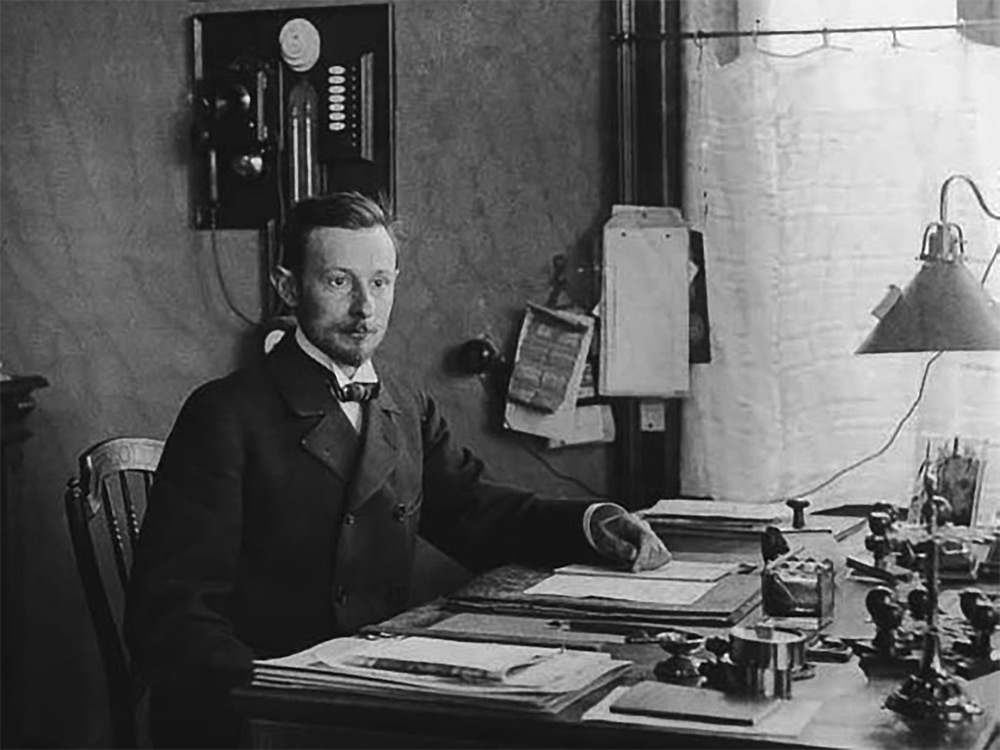
Bernhard Dräger in the office of “Drägerwerk, Heinr. & Bernh. Dräger” in Lübeck in 1904
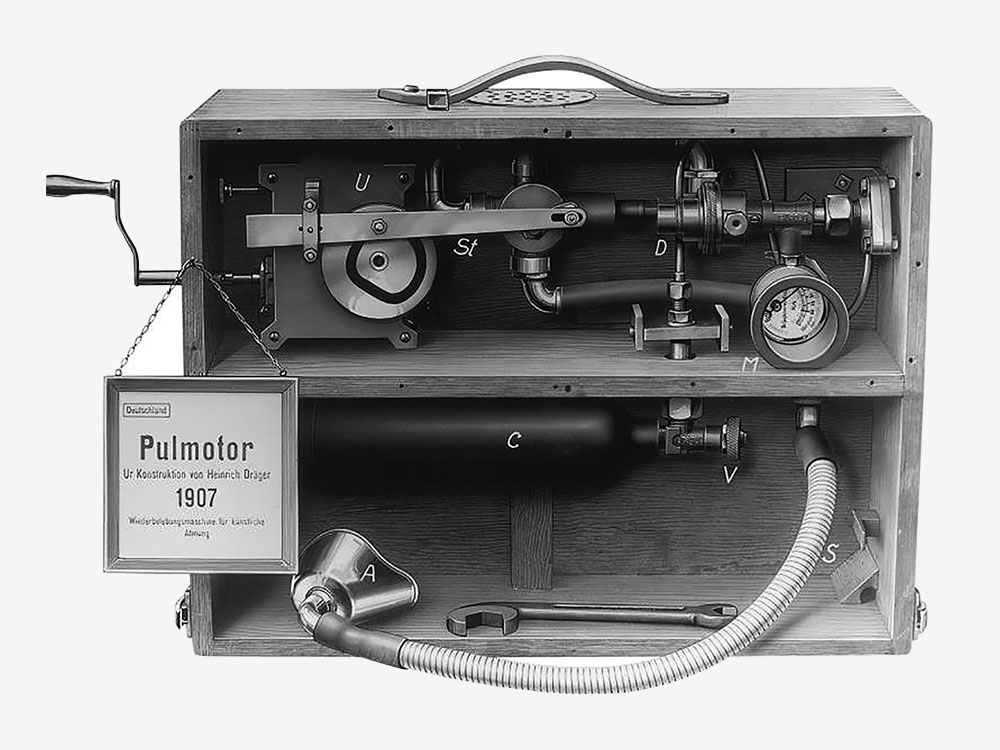
“Pulmotor” prototype
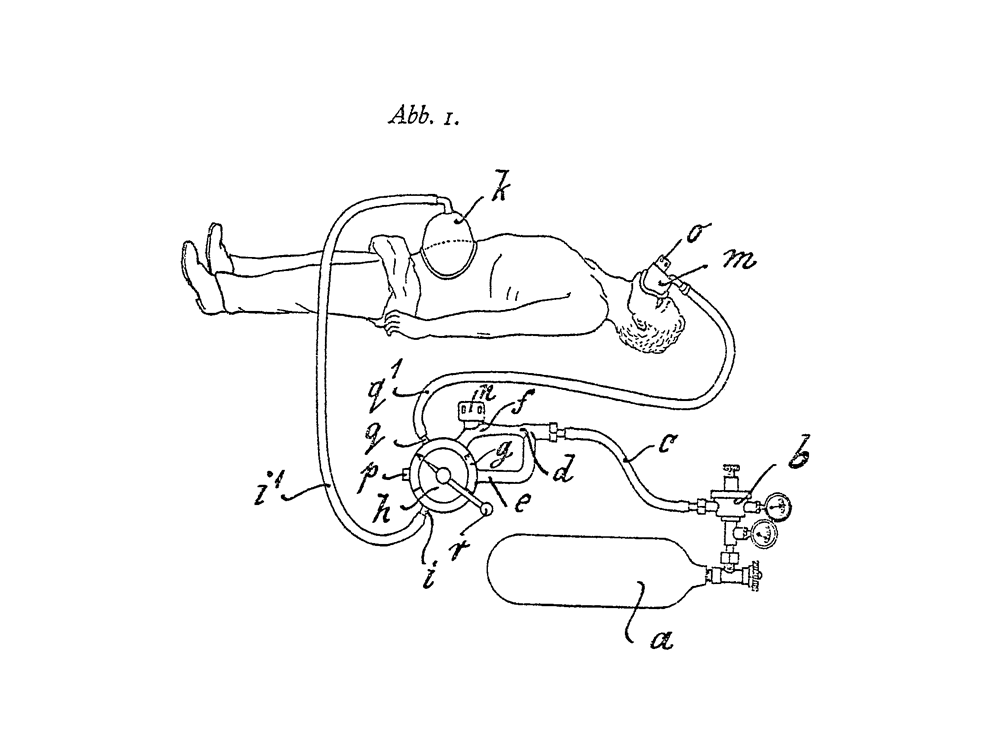
Figure of patent specification no. 384245
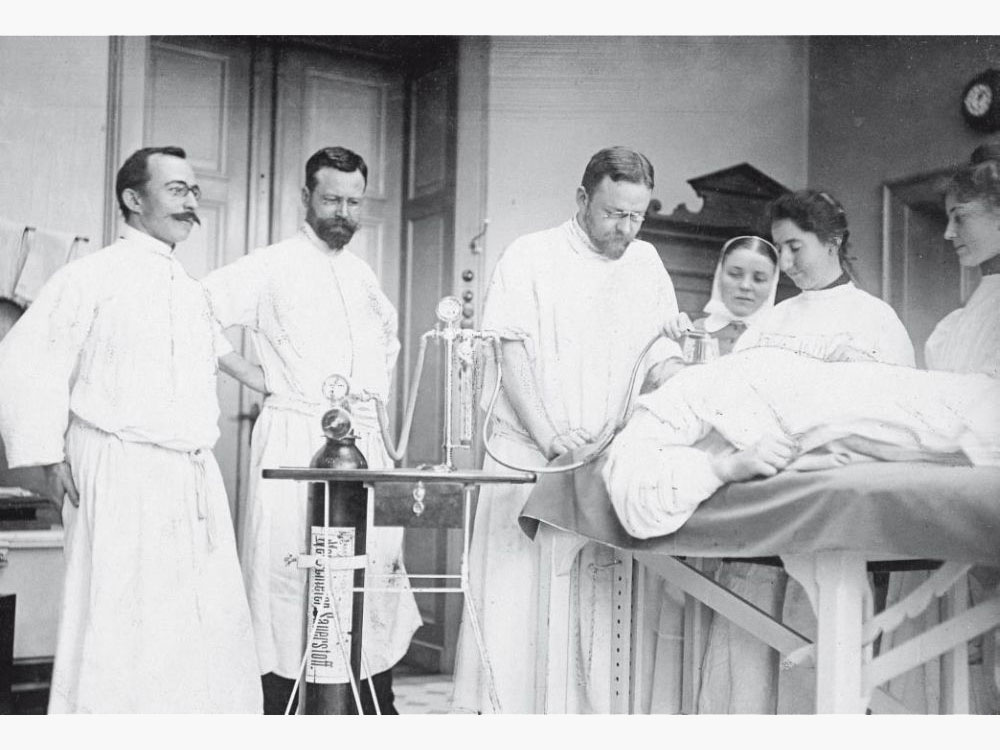
"Roth-Dräger" anesthesia apparatus in use
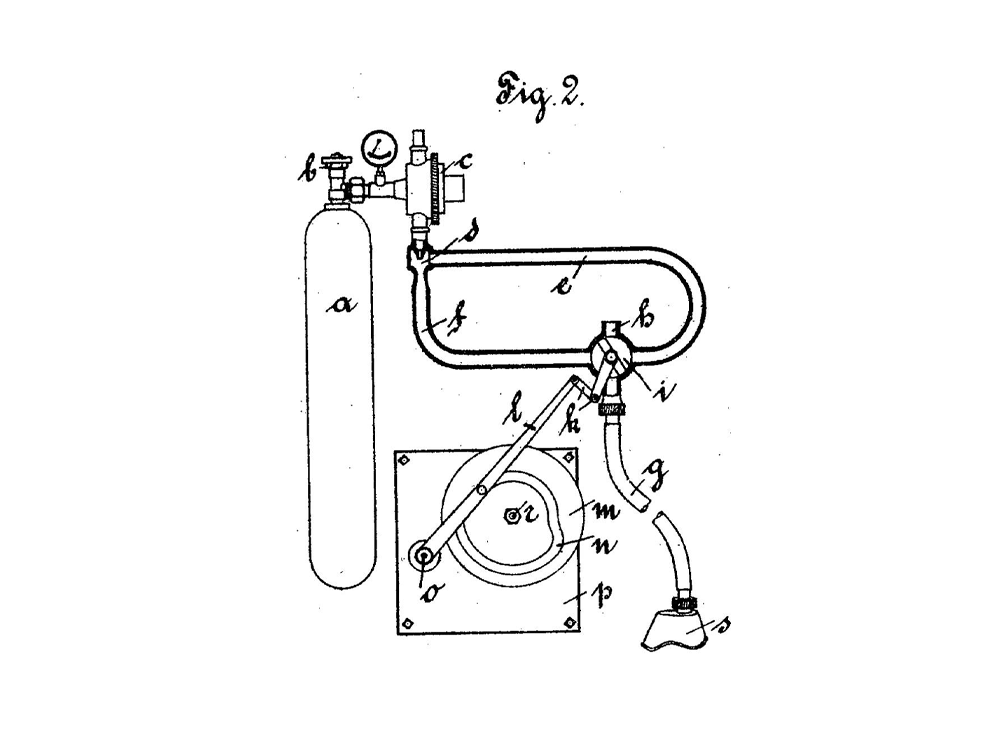
Device for the generation of artificial respiration (figure of patent specification no. 211138)
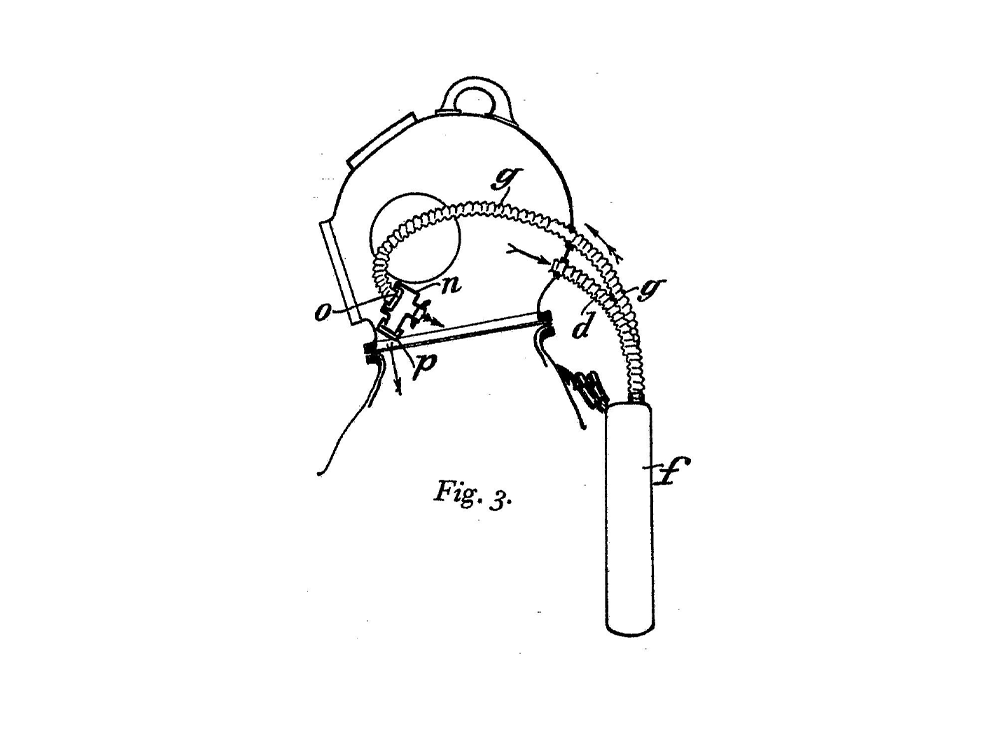
Respiratory system, especially for divers (figure of patent specification no. 331363)
Bernhard Dräger recognised the potential of compressed oxygen as a fundamental technology. “Drägerwerk” became primarily known for its breathing apparatus for the mining industry. From 1901 onwards, Dräger concentrated his development efforts on respiratory protection. The actual breakthrough came with the successful rescue apparatus model 1904. These devices, constantly improved by him, were soon being used in underground mining all over the world. In 1907, Dräger opened a branch in New York. Even today, rescue workers in the US mining industry are known as “draegermen” because of their breathing apparatus.
“Pulmotor” for ventilation
The Drägers and Otto Roth, a surgeon, developed the first anaesthesia machine, in which chloroform or ether was nebulised in a pressurised oxygen stream and inhaled together with pure oxygen by the patient. In 1902, the problem of dosage, which was a major problem at that time, was solved by the “Roth-Dräger” mixed anaesthetic apparatus.
However, the father Heinrich made one of the most important inventions of the company: the first ventilator in the world, the “Pulmotor” (see, for example, DE211138, DE384245). It operated with oxygen under pressure and alternatively produced positive and negative airway pressure. The ventilator supplied breathing gas until a certain pressure was reached in the lungs; then it switched to exhalation. In 1907, it was first used by the Berlin fire brigade. It became a great success and, essentially unchanged, remained in use for decades.
Escape sets and gas masks
In 1907, Bernhard Dräger also developed the escape sets for submarine crews called “Tauchretter” (diving rescuer) (see DE529399). He also designed air purification systems and tubeless oxygen underwater breathing apparatus for depths of up to 80 metres (see, for example, DE331363). For the emergent aircraft technology (balloons and airplanes) he designed high-altitude breathing apparatus for flights in atmospheric layers that are low in oxygen. At the outbreak of World War I, the Drägerwerk factory was converted to wartime production and delivered millions of gas masks (see e.g. DE401706).
Between 1900 and 1928, 261 German and 443 foreign patents as well as 912 utility models were granted to Bernhard Dräger and his father, according to corporate information. On 12 January 1928, Bernhard Dräger died at just 57.
Today, the Dräger company, now headed by his great-grandson Stefan, is still considered one of the leading manufacturers of medical and safety equipment. In 2020, due to the coronavirus.